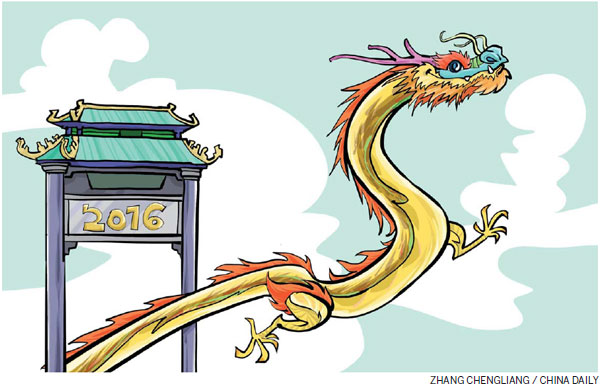China slowing, but its impact growing
Updated: 2016-01-15 07:42
By Giles Chance(China Daily Europe)
|
|||||||||||
The dampening price effect of country's exports on Western inflation, which started in the 1990s, remains
China's emergence in the global economy since the mid-1990s has affected the rest of the world in increasingly important ways.
Today, no one would question the international importance of the world's second-largest economy. This international recognition started in earnest when China resumed its fast growth in 2003, after the long pause that followed the Asian financial crisis in 1997. China's huge demand for raw materials to feed its building boom drove the prices of oil, copper, iron ore and other commodities to sky-high levels, enriching commodity producers like Zambia and Brazil in the emerging world, and Australia and Canada in the developed world.

Later, as commodity demand cooled and prices fell, and as China rebalanced its economy, commodity importers such as Japan and Germany benefited at the expense of commodity producers.
The recent climate change meeting in Paris underlined China's importance to any agreement, as it is the largest industrial power and the largest producer of industrial pollution. The formation of the Asian Infrastructure Investment Bank, which has received widespread international support, and the development of the ambitious Belt and Road Initiative to link China with Central Asia, Europe and beyond have also both highlighted China's global importance.
Back in 1995, most people in the West thought of China only as an interesting relic of history. They did not think the country could ever have any meaningful, permanent effect on their lives. But even then, China's international economic impact had already begun. Foreign companies had started to buy products made by factories in southeast China that were much cheaper than they could make themselves, and that they could import to sell in their home markets.
The Asian crisis of 1997, which came on top of then-premier Zhu Rongji's industrial restructuring, forced the Chinese government to look for ways to maintain economic growth in the face of a massive regional slowdown. The next year, commerce minister Wu Yi visited southeastern China to boost international trade, encouraging foreign companies to buy from Chinese factories.
Since then, China's exports have boomed, growing seven times in value between 1998 and 2005, as China's accession to the World Trade Organization in 2002 accelerated the country's trade links with main export markets in the United States and Europe. Many Western companies that came to rely on Chinese imports, such as Wal-Mart and Gap in the US, and Carrefour and Metro in Europe, made huge profits as their product costs fell.

But part of that windfall was passed onto Western consumers. The effect on the West of this huge wave of Chinese imports was to provide consumers with ever-lower prices for a wide range of everyday products, from electronics to clothing to household and outdoor products. Falling prices for everyday items enriched Western buyers. Lower prices affected Western consumer price indices.
Western economists such as Ben Bernanke, who went on to become chairman of the US Federal Reserve, were alarmed by static price levels, because they thought that falling prices, or price deflation, signaled economic depression. Their remedy was to print more money to offset lower prices and maintain economic growth, and to keep the cost of money very low. The Fed agreed with this analysis, and US interest rates stayed low for several years.
This dollar-printing caused an explosion of debt, which led to the financial crash of 2008. China certainly cannot be blamed for the credit crisis of 2008, but the country's emergence and success as global manufacturer certainly played an important role in it.
In 2015, price inflation has remained very low in the West. This is partly the legacy of the 2008 economic disruption, which although US in origin had global consequences. But it's also the continued effect of industrial globalization. The dampening price effect of China's exports on Western inflation, which started in the 1990s, remains.
Chinese salaries started to increase in 2007 by 15 to 20 percent a year. But Chinese productivity growth was enough to offset these wage increases. Production of some low-value goods moved from Southeast China to Vietnam or India. In other cases, companies such as Foxconn, which makes the iPhone, opened factories in western China to escape soaring land and labor costs in the country's east.
It's easy to separate the downward impact on the US inflation index of items imported from China or other low-cost countries, and contrast that with the inflationary effect of goods or services that cannot be imported.
Taking the period between 2007 and October in 2015, when the most recent data was published, in the US, items like college tuition, physician and hospital costs, trash removal and housing all rose considerably. College tuition in the US rose 43 percent, financial services were up 17 percent, dentistry costs by 24 percent, domestic services by 12 percent and laundry dry-cleaning by 20 percent.
But overall inflation remained low because energy costs fell, as China slowed and the oil boom faded, and also because many imported consumer items continued to fall in price. Toys fell 22 percent in price, and prices of personal computers fell 53 percent, furniture and bedding (mostly imported from China) by 8 percent, and sports equipment by 10 percent.
But as labor costs in China continue to rise, and in the event of the industrial consolidation promised by Premier Li Keqiang for 2016, can China's low industrial costs continue to provide a dampening effect on Western price levels?
Excess industrial production capacity has started to become obvious in China's steel industry. Surplus Chinese steel production has driven down steel prices in Europe and the US in 2015. Year-to-date in September, US steel imports from China totaled 27 million metric tons, compared with only 60 million tons of steel produced in the US. Mittal Steel, the world's largest steel producer, said in October that its business was being severely damaged by Chinese steel imports in Europe.
The combination of China's economic slowing and its huge capacity in a range of key industries means the country now has massive excess industrial capacity, which the government says it will cut. If this happens, what will the effect of reduced supply be on Western markets?
At some point, the downward pressure from China on prices will weaken, and in certain areas may cease. Does this mean that core Western inflation, outside of energy costs, could start to rise?
The US Federal Reserve seems certain to raise rates this month, but the low price-inflation level in the US seems to show that rate rises will be slow and small. But if the downward pressure on US price levels from Chinese imports becomes weaker, so that consumer price inflation rises faster than expected, interest rate rises could become more frequent and larger.
What would happen then to the markets, such as stocks and real estate, which have benefited so much from the long period of very low interest rates? They could fall sharply.
China's international impact could become even larger in 2016 and 2017.
The author is a visiting professor at Guanghua School of Management, Peking University. The views do not necessarily reflect those of China Daily.
(China Daily European Weekly 01/15/2016 page10)
Today's Top News
Chinese people revealed as most optimistic
in global survey
COSCO offers 700m euros for Greece’s Piraeus Port
Istanbul bomber entered Turkey as refugee
Bird flu case confirmed in eastern Scotland
Cosco poised for Piraeus control
US President Obama delivers final State of the Union address
Iran confirms detention of 10 US marines
Ten killed in Istanbul blast
Hot Topics
Lunar probe , China growth forecasts, Emission rules get tougher, China seen through 'colored lens', International board,
Editor's Picks

|

|

|

|

|

|






